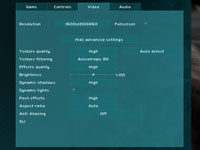Ghost Recon Advanced Warfighter:
Publisher: UbisoftWe used the latest addition to Tom Clancy's Ghost Recon series - Ghost Recon Advanced Warfighter and patched the game to version 1.21. This has to be one of the best-looking games on the market at the moment, even despite its lack of support for anti-aliasing on any of today's current hardware. The game makes use of High Dynamic Range lighting and a whole plethora of special effects. Probably the biggest talking point for Ghost Recon Advanced Warfighter is its support for AGEIA's PhysX PPU.
The lack of support for anti-aliasing may seem like a backwards step in image quality, as there are many areas of the game that could certainly benefit from a multisample anti-aliasing pattern. The lack of anti-aliasing support is due to the fact that the game uses multiple render targets to achieve some of the advanced graphical effects. This is due to the way that the DirectX 9.0 specification was set out, and even if multiple render targets and anti-aliasing could work in harmony, it'd be incredibly costly because every surface in the multiple render target would need to be sampled.
We did a five minute manual run through from the start of the Strong Point level. This incorporates lots of post processing effects, HDR lighting, explosions, gun fire and water, too in order to give the graphics subsystem a good work out. The game has no support for anti-aliasing, but anisotropic filtering was controlled from inside the game.


On EVGA's card, we could increase the dynamic shadow and post effect quality to high, while effects and textures remained set at low and medium respectively. The Radeon X1900GT was as fast as Galaxy's GeForce 7900 GS and we were able to turn high quality anisotropic filtering on while maintaining acceptable frame rates. These frame rates were not as high as those experienced on the GeForce 7900 GS cards, but the all-important minimum frame rate was as high as we experienced on the other cards tested.
The ugly duckling in the bunch was the Radeon X1800GTO – the gaming experience wasn't great, even with all of the details turned down, except dynamic lights. In order to maintain similar frame rates to the other cards, you're probably best turning HDR off, in all honesty.

MSI MPG Velox 100R Chassis Review
October 14 2021 | 15:04







Want to comment? Please log in.